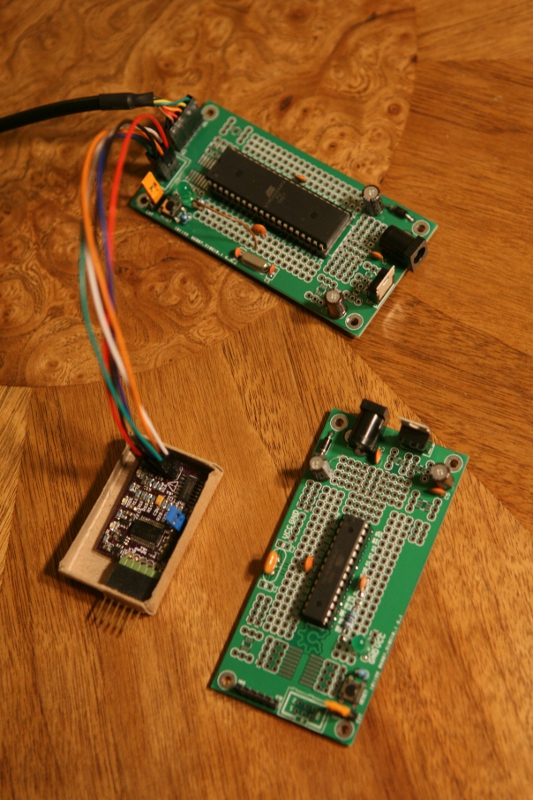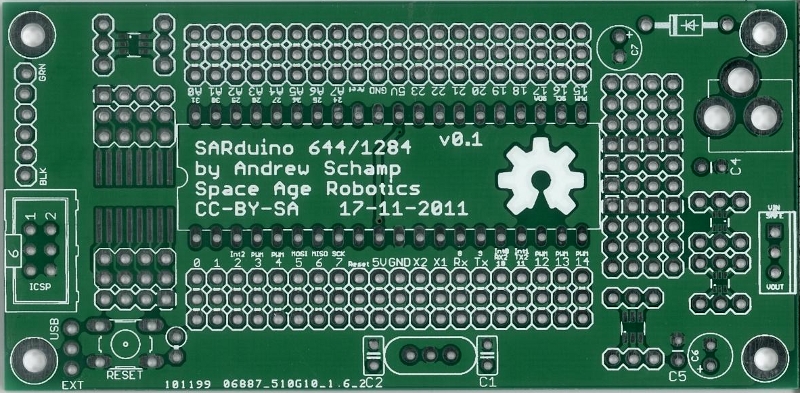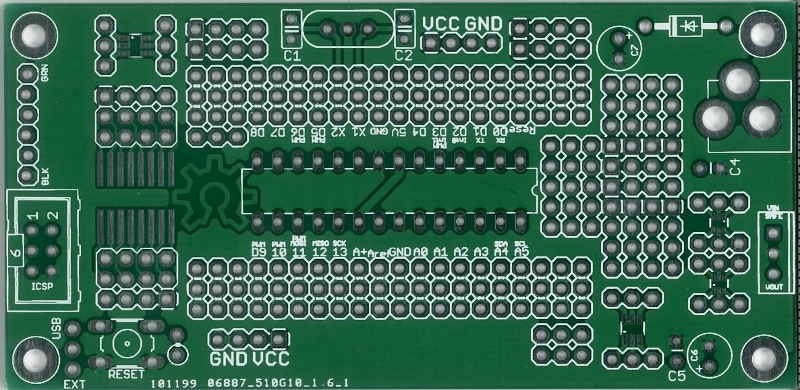Introduction
SARduino (that is, “Space-Age-Robotics-duino”) is an open source Arduino-compatible project board. It is designed to be committed to a project, and to that end, I have tried to make it inexpensive, and with enough flexibility and prototyping area to implement simple projects directly on the board (and to allow more complex circuits with daughterboards made on protoboard). The SARduino board includes small breakout areas for SMD devices (SOIC-16, SOT-23-6 and SC-70-6) and an FTDI cable header for programming (in addition to an ISP header). It supports external an power regulator circuit or direct connection of regulated 5V (or 3.3V).
There are two varieties, a DIP-28 ATmega8/168/328 Boarduino-based board (SARduino328) and a DIP-40 ATmega644/1284 Sanguino-based board (SARduino644).
Features
- In v0.1:
- SOIC (W)-16 breakout area
- 2x SOT-23-6 breakout area
- 2x SC-70-6 breakout area
- External power circuit for In-Gnd-Out TO-220 regulator
- ICSP programming header
- FTDI Cable connection for Arduino-compatible programming
- External crystal oscillator or ceramic resonator
- Breakout strips for each microcontroller pin
- Miscellaneous breakout areas
- Added in v1.0:
- Auto-reset circuit
- FTDI connector breakout
- Extra power and ground rails
Design Notes
I had originally tried designing a 2-sided board that was a complete ATmega328 circuit on one side, and a complete ATmega644 circuit on the other side, so that if I had a batch of boards made, I could use them for either MCU. Furthermore, I had hope that the one-sided circuit might be suitable for home PCB fab processes, like toner transfer or direct resist print. Unfortunately, this goal was too ambitious. The extra circuitry (solder bridge, etc.) and strange device packages (a reversible 2.1mm jack package, and a reversible voltage regulator, among other things) made it difficult to get either circuit to fit all on one side. It does include support for either a ceramic resonator with integrated capacitors, or a crystal oscillator with external capacitors.
I had set it up to have breakout area for small SMD devices that are hard to use on protoboard, and I tried to add small prototyping areas wherever they might fit. Early versions did not include the Arduino auto-reset capacitor as part of the FTDI-cable circuit (though it was added in 644 v1.0). Also, there is neither a power LED, nor an LED on pin 13 (or pin 0 on the 644 variety) to flash when the bootloader is running, but there is enough prototyping area to implement that if desired.
The board is designed to fit within the 5x10cm area supported by the low-cost prototyping services provided by ITead Studio and Seeed Studio.
Revisions
The design files for the SARduino are stored in the Space Age Robotics github repository, and specific releases are provided below. See each revision page for schematic, PCB artwork, bill of materials, and errata.
Both boards are released under a Creative Commons license, CC-BY SA 3.0. All versions can be found in the SARduino github repository, and should be clearly marked with the version number on the PCB.
| Revision | Design Files | Schematic | PCB | Gerbers |
|---|---|---|---|---|
| SARduino328 v0.1 | everything (.zip) | .sch .png | .brd .png | single.zip |
| SARduino644 v0.1 | everything (.zip) | .sch .png | .brd .png | single.zip |
| SARduino644 v1.0 | everything (.zip) | .sch .png | .brd .png | single.zip panel.zip |



